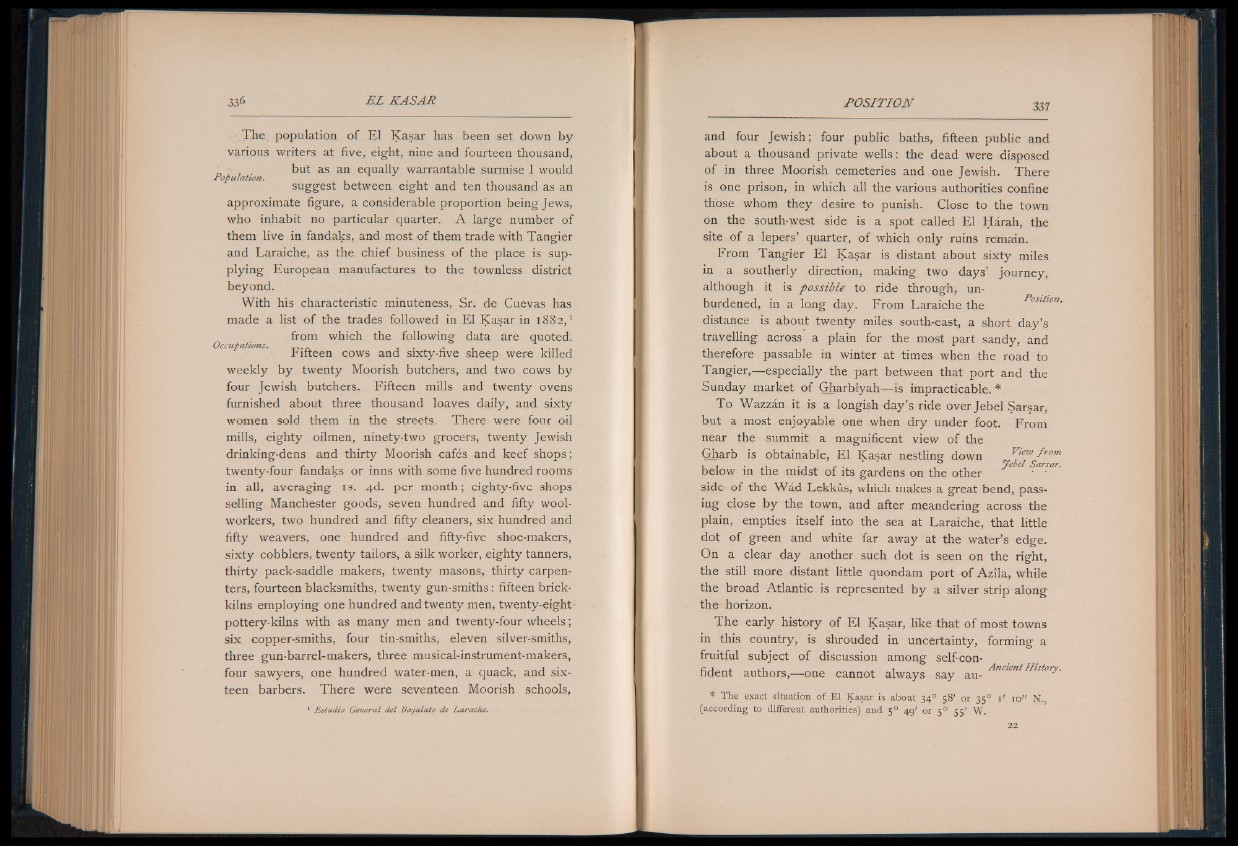
The population of El Kasar has been set down by
various writers at five, eight, nine and fourteen thousand,
_ , but as an equally warrantable surmise I would
Population.
suggest between eight and ten thousand as an
approximate figure, a considerable proportion being Jews,
who inhabit no particular quarter. A large number of
them live in fandaks, and most of them trade with Tangier
and Laraiche, as the chief business of the place is supplying
European manufactures to the townless district
beyond.
With his characteristic minuteness, Sr. de Cuevas has
made a list of the trades followed in El Kasar in 1882,1
from which the following data are quoted.
Occupations. .
finteen cows and sixty-five sheep were killed
weekly by twenty Moorish butchers, and two cows by
four Jewish butchers. Fifteen mills and twenty ovens
furnished about three thousand loaves daily, and sixty
women sold them in the streets. There were four oil
mills, eighty oilmen, ninety-two grocers, twenty Jewish
drinking-dens and thirty Moorish cafés and keef shops;
twenty-four fandaks or inns with some five hundred rooms
in all, averaging is. 4d. per month; eighty-five shops
selling Manchester goods, seven hundred and fifty wool-
workers, two hundred and fifty cleaners, six hundred and
fifty weavers, one hundred and fifty-five shoe-makers,
sixty cobblers, twenty tailors, a silk worker, eighty tanners,
thirty pack-saddle makers, twenty masons, thirty carpenters,
fourteen blacksmiths, twenty gun-smiths: fifteen brickkilns
employing one hundred and twenty men, twenty-eight
pottery-kilns with as many men and twenty-four wheels;
six copper-smiths, four tin-smiths, eleven silver-smiths,
three gun-barrel-makers, three musical-instrument-makers,
four sawyers, one hundred water-men, a quack, and sixteen
barbers. There were seventeen Moorish schools,
1 Estudio General del Bajalato de L a r ache.
and four Jewish; four public baths, fifteen public and
about a thousand private wells: the dead were disposed
of in three Moorish cemeteries and one Jewish. There
is one prison, in which all the various authorities confine
those whom they desire to punish. Close to the town
on the south-west side is a spot called El Hárah, the
site of a lepers’ quarter, of which only ruins remain.
From Tangier El Kasar is distant about sixty miles
in a southerly direction, making two days’ journey,
although it is possible to ride through, unburdened,
in a long day. From Laraiche the
distance is about twenty miles south-east, a short day’s
travelling across a plain for the most part sandy, and
therefore passable in winter at times when the road to
Tangier,^especially the part between that port and the
Sunday market of Gharbiyah— is impracticable. *
To Wazzán it is a longish day’s ride over Jebel Sarsar,
but a most enjoyable one when dry under foot. From
near the summit a magnificent view of the
Gharb is obtainable, El Kasar nestling down View from
* yebel Sarsar
below in the midst o f its gardens on the other \ ■
side of the Wád Lekküs, which makes a great bend, passing
close by the town, and after meandering across the
plain, empties itself into the sea at Laraiche, that little
dot of green and white far away at the water’s edge.
On a clear day another such dot is seen on the right,
the still more distant little quondam port of Azila, while
the broad Atlantic is represented by a silver strip along
the horizon.
The early history of El Kasar, like that o f most towns
in this country, is shrouded in uncertainty, forming a
fruitful subject of discussion among self-confident
authors,— one cannot always say au- AnaentHlstory-
* The exact situation of El Kasar is about 34o 58' or 35° }> 10" N.,
(according to different authorities) and 50 49' or 50 55' W.